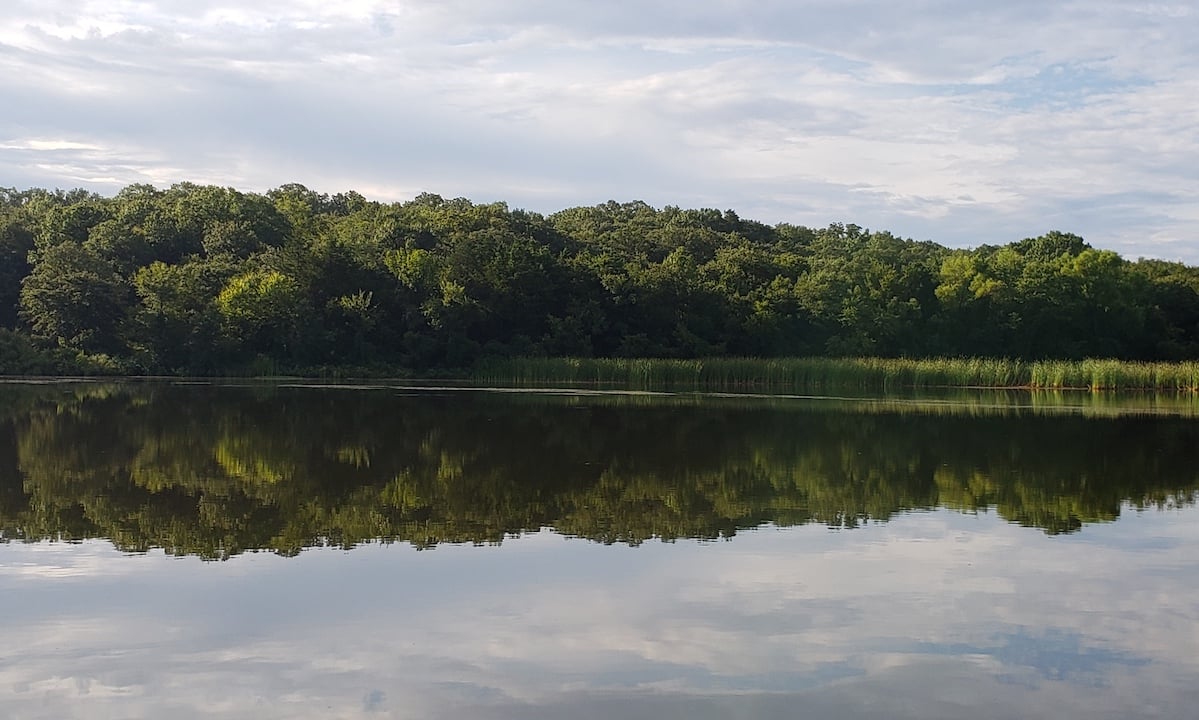Not surprisingly, the answer to that question is: It depends. If you want a clear swimming hole, or trophy bass lake, the optimum water clarity will be different.
Pond Clarity
The clarity or visibility of your pond affects many aspects of your pond's specific ecosystem. Primary productivity, vegetation growth and abundance, fish condition, and dissolved oxygen concentration are all influenced by water clarity. Water clarity is affected by a large number of factors including: suspended solids (t.s.s), turbidity (number of individual particles), and density of microorganisms (phytoplankton). By managing these factors, you can manipulate the clarity of your pond to best suit your goals for the pond.
Just How Clear is Your Pond?
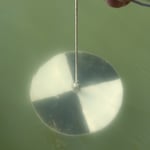 The clarity of your pond is measured by lowering a black and white disc known as a secchi disc down to the point where you can no longer clearly see it. When you lose sight of the disc, mark the position on the rope and measure in inches down to the disc. This is best done in a sunny portion of the dock or off the sunny side of the boat to get the most accurate results.
The clarity of your pond is measured by lowering a black and white disc known as a secchi disc down to the point where you can no longer clearly see it. When you lose sight of the disc, mark the position on the rope and measure in inches down to the disc. This is best done in a sunny portion of the dock or off the sunny side of the boat to get the most accurate results.
Pond Clarity can be a Murky Issue
The ideal clarity for you and your pond is dependent on your intended use for the pond. If you want a clear swimming hole, or trophy bass lake, the recommended water clarity will be different. Too clear and too dirty/muddy can both lead to decreased relative weights of fish, so for the successful fishery it is best to be somewhere in the middle.
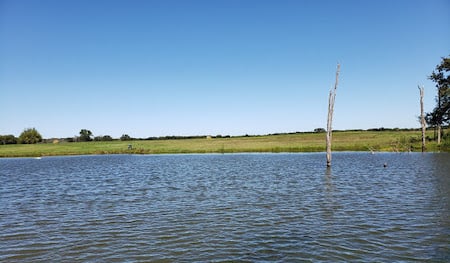 As a good rule of thumb optimal clarity for Largemouth Bass (Micropterus salmoides) production is about 18-24 inches of visibility (as seen above). Largemouth are ambush predators and rely heavily on eyesight and vibrations detected through their lateral lines to locate forage species. When subjected to environments with less than 18 inches of clarity bass have to almost exclusively use their lateral line to locate their forage. This in turn makes them a less effective predator. When present in an environment with greater than 24 inches of clarity, the bass are able to effectively utilize both eyesight and their lateral line to locate and feed on forage species. However, as visibility increases the bass’s ability to ambush decreases.
As a good rule of thumb optimal clarity for Largemouth Bass (Micropterus salmoides) production is about 18-24 inches of visibility (as seen above). Largemouth are ambush predators and rely heavily on eyesight and vibrations detected through their lateral lines to locate forage species. When subjected to environments with less than 18 inches of clarity bass have to almost exclusively use their lateral line to locate their forage. This in turn makes them a less effective predator. When present in an environment with greater than 24 inches of clarity, the bass are able to effectively utilize both eyesight and their lateral line to locate and feed on forage species. However, as visibility increases the bass’s ability to ambush decreases.
Bass are less effective open water predators and are required to expend greater amounts of energy to chase their forage, in turn decreasing their growth rates. When presented with environments within 18-24 inches of visibility bass are able to utilize sight and vibrations through their lateral line all while still effectively maintaining an ambush feeding strategy. This allows for greater net nutrient gain as less energy is needed to be expended on each meal.
Problems Associated with Clarity Extremes
Too Clear
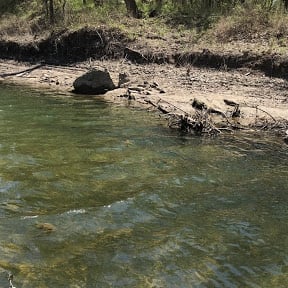 One of the most common issues associated with really clear ponds is overabundant submergent vegetation growth. Submergent species such as coontail, baby pondweed, and southern naiad have strong tendencies to take over any area of substrate that has adequate amounts of sunlight. Clear water allows sunlight to penetrate deeper into the water column and creates more suitable area for aquatic plants to grow on the bottom of your pond. Once species such as the ones listed earlier have established they can be difficult to control. Means of controlling include chemical treatments or biological controls such as grass carp (Ctenopharyngodon idella). Chemical controls can be costly while biological controls take considerable time to really make a noticeable effect.
One of the most common issues associated with really clear ponds is overabundant submergent vegetation growth. Submergent species such as coontail, baby pondweed, and southern naiad have strong tendencies to take over any area of substrate that has adequate amounts of sunlight. Clear water allows sunlight to penetrate deeper into the water column and creates more suitable area for aquatic plants to grow on the bottom of your pond. Once species such as the ones listed earlier have established they can be difficult to control. Means of controlling include chemical treatments or biological controls such as grass carp (Ctenopharyngodon idella). Chemical controls can be costly while biological controls take considerable time to really make a noticeable effect.
In order to decrease clarity to reduce light penetration we often suggest fertilizing your pond in spring. Fertilizing your pond has numerous beneficial effects and is highly suggested when your pond is greater than 2 acres. Aquatic fertilizer consists of a mixture of Nitrogen, Phosphorus, and Potassium. When dispersed in aquatic ecosystems, these inorganic nutrients facilitate primary production and feed the ecosystem from the bottom up. Primary production is the process of converting inorganic nutrients and sunlight into organic compounds. This is important in your pond because it is the basis for the entire food chain in your aquatic ecosystem. Phytoplankton fixate these inorganic compounds into organic energy within their body that gets released into the next organism in the food chain upon predation. In short, fertilizer “feeds” the smallest organisms in the food chain so it can better feed the larger organisms hence “bottom-up” fertilization.
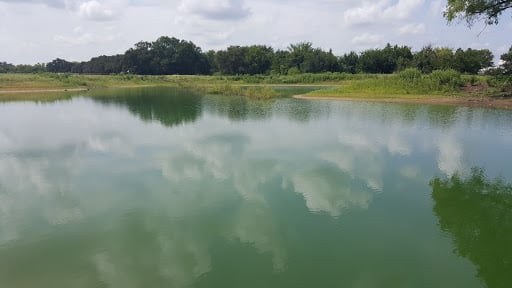
Following fertilization, increased abundance of nutrients facilitates a bloom of photosynthetic organisms called phytoplankton. This bloom creates a green tint to the water and decreases visibility. This results in decreased light penetration limiting the area of substrate submergent vegetation can grow, increased usage of available nutrients while decreasing amounts of nutrients available for vegetation, and increasing production potential within the fish community.
Too Dirty
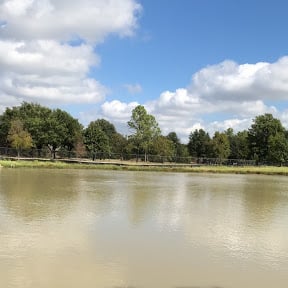 Issues associated with low visibility in your lake or pond are aesthetics, decreased predator efficiency, and in some cases decreased dissolved oxygen concentrations. Do not get me wrong, bass and other gamefish will still live and grow in muddy water situations, but their growth rates and relative weights often times will be under potential. Decreased light penetration limits the amounts of vegetation and phytoplankton growth. Photosynthetic organisms such as aquatic vegetation and phytoplankton contribute to the dissolved oxygen concentration in your pond through photosynthesis. When phytoplankton and aquatic vegetation can only grow in a few inches of the water column this significantly decreases the carrying capacity of these organisms and contributes less oxygen to the water. This can result in oxygen depletion during the summer when increased water temperatures contain less oxygen. Depletion and fish kills can be common in small shallow ponds that do not have an aeration device.
Issues associated with low visibility in your lake or pond are aesthetics, decreased predator efficiency, and in some cases decreased dissolved oxygen concentrations. Do not get me wrong, bass and other gamefish will still live and grow in muddy water situations, but their growth rates and relative weights often times will be under potential. Decreased light penetration limits the amounts of vegetation and phytoplankton growth. Photosynthetic organisms such as aquatic vegetation and phytoplankton contribute to the dissolved oxygen concentration in your pond through photosynthesis. When phytoplankton and aquatic vegetation can only grow in a few inches of the water column this significantly decreases the carrying capacity of these organisms and contributes less oxygen to the water. This can result in oxygen depletion during the summer when increased water temperatures contain less oxygen. Depletion and fish kills can be common in small shallow ponds that do not have an aeration device.
Oftentimes very low visibility in ponds is due to the amount of suspended solids in the water column. Muddy water is very common with new ponds and should be allowed ample time for the sediments and other solids to settle. A rule of thumb would be to wait a month after your surrounding ground has grown back some grass and other vegetation to control soil erosion. After that month if your pond still has not settled out, a gypsum treatment may be necessary to increase clarity. Gypsum binds with suspended clay particles and sinks them to the bottom and out of the water column thus increasing clarity. Soil erosion from heavy rains will often muddy up ponds for a few days or a week, but often settle out again in time. This is natural and is actually beneficial for the ecosystem as new nutrients get washed into the water with the runoff. Another contributor to a muddy pond may be a fountain that has been placed either in a shallow pond or in a shallow portion of the pond. Often times the pumps on these fountains can create an updraft of water that extends down to the bottom and disperses substrate sediment throughout the water column. To test if this is the case in your pond turn off or unplug your fountain for a week or so and evaluate if you see an increase in visibility. If so, you may need to reposition your fountain into deeper water.
Hopefully, this helps you understand pond clarity and issues associated with it. If you have any more questions, feel free to call or email us and we will get back with you as soon as we can to answer any further questions. Or, check out the Pond King DIY Pond Management iPhone App.
See y'all down at the pond.


